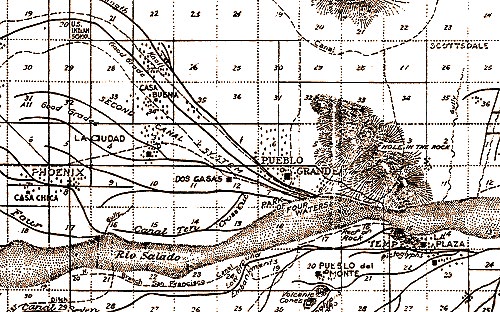

The distinctive Hohokam pattern of life began sometime after the time of Christ. Hohokam origins have been attribued either to an internal development from an earlier hunting and gathering group or to a immigation of people from Mexico. Typical parts of Hohokam material culture such as pottery, shell, and worked stone artifacts give evidence that the Hohokam existed in earlier periods. The Pioneer period is the first time period. An agricultural way of life based on the domestication of corn, beans, squash, and cotton emerged. Distinctive Hohokam pottery, shell, stone, and figurine artifacts were made.
The Colonial period witnessed the expansion of an irrigation system to support agriculture. Irrigation systems expanded and became more sophisticated, serving a growing population. Ballcourts began to be constructed. These communal structures probably served as means to bond people and as places for interaction. And, there was increased trade. Artifacts became more elaborate, and a general flare to arts and crafts emerged.
During the Sedentary period that followed, sites were larger, and there were more of them. There also were more different types of sites in the Sedentary period. Some sites had both ballcourts and and large plazas. Irrigation systems continued to be increased throughout this period as population continued to grow. Designs on ceramics changed, and there were more diverse forms of ceramic vessels.

The Classic period is marked by changes in architecture, material
culture, and other aspects of culture. Surface adobe structures known as
compounds become common. These walled enclosures contained from four to
ten special purpose rooms and habitation spaces facing a coutyard. Massive
adobe platform mounds like that found at Pueblo Grande were built, and the
use of ballcourts declined. Items such as stone bowls, effigy figurines,
and stone pallettes were no longer made. Ceramic styles changed to ceramic
vessels with a polished red color and multiple colors known as polychromes
(red, black and white). Subtle population shifts in village locations are
noted as are changes in burial practice at this time.
There are no good explanations for these dramatic changes that occurred in Hohokam culture during the Classic period. Some archaeologists theorize that influence from a culture known as the Salado, originally found in the Globe and Lake Roosevelt area to the northeast of Phoenix, was a cause. The Salado themselves may have been influenced by Puebloan people of northern Arizona. Just how the Salado may have influenced the people living along the Salt and Gila Rivers around Phoenix is unclear. Some suggest that there was a migration, while others argue that a new way of life was simply adopted by the people living here in the valley.
Even later, the people living in the Phoenix area abandoned their homes. When the first Europeans arrived in the area, they report that no one was living here, although they found traces of the Hohokam in sites such as Pueblo Grande and in the form of canals. It was the lure of the canals that led these new arrivals to once again irrigate the deserts along the Salt River. The image of a new beginning rising from the old ways is of a Phoenix Bird rising from the ashes of an old city. The new use of the canals of the previous valley residents gives Phoenix its identity.
|